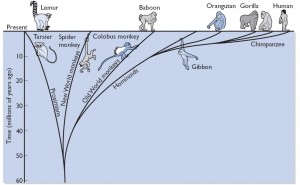![]() Much of recent research in linguistics has involved the use of experimentation to directly test hypotheses by comparing and contrasting real-world data with that of laboratory results and computer simulations. In a previous post I looked at how humans, non-human primates, and even non-human animals are all capable of high-fidelity cultural transmission. Yet, to apply this framework to human language, another set of experimental literature needs to be considered, namely: artificial language learning and constructed communication systems.
Much of recent research in linguistics has involved the use of experimentation to directly test hypotheses by comparing and contrasting real-world data with that of laboratory results and computer simulations. In a previous post I looked at how humans, non-human primates, and even non-human animals are all capable of high-fidelity cultural transmission. Yet, to apply this framework to human language, another set of experimental literature needs to be considered, namely: artificial language learning and constructed communication systems.
Category: Science
Some Links #13: Universal Grammar Haters
Universal Grammar haters. Mark Lieberman takes umbrage with claims that Ewa Dabrowska’s recent work challenges the concept of a biologically evolved substrate for language. Put simply: it doesn’t. What their experiments suggest is that there are considerable differences in native language attainment. As some of you will probably know, I’m not necessarily a big fan of most UG conceptions, however, there are plenty of papers that directly deal with such issues. Dabrowska’s not being one of them. In Lieberman’s own words:
In support of this view, let me offer another analogy. Suppose we find that deaf people are somewhat more likely than hearing people to remember the individual facial characteristics of a stranger they pass on the street. This would be an interesting result, but would we spin it to the world as a challenge to the widely-held theory that there’s an evolutionary substrate for the development of human face-recognition abilities?
Remote control neurons. I remember reading about optogenetics awhile back. It’s a clever technique that enables neural manipulation through the use of light-activated channels and enzymes. Kevin Mitchell over at GNXP classic refers to a new approach where neurons are activated using a radio frequency magnetic field. The obvious advantage to this new approach being fairly straight-forward: magnetic-fields pass through brains far more easily than light. It means the new approach is a lot less invasive, without the need to insert micro-optical fibres or light-emitting diodes. Cool stuff.
Motor imagery enhances object recognition. Neurophilosophy has an article about a study showing that motor simulations may enhance the recognition of tools:
According to these results, then, the simple action of squeezing the ball not only slowed down the participants’ naming of tools, but also slightly reduced their accuracy in naming them correctly. This occured, the authors say, because squeezing the ball involves the same motor circuits needed for generating the simulation, so it interferes with the brain’s ability to generate the mental image of reaching out and grasping the tool. This in turn slows identification of the tools, because their functionality is an integral component of our conceptualization of them. There is other evidence that parallel motor simulations can interfere with movements, and with each other: when reaching for a pencil, people have a larger grip aperture if a hammer is also present than if the pencil is by itself.
On the Origin of Science Writers. If you fancy yourself as a science writer, then Ed Yong, of Not Exactly Rocket Science, wants to read your story. As expected, he’s got a fairly large response (97 comments at the time of writing), which includes some of my favourite science journalists and bloggers. It’s already a useful resource, full of fascinating stories and bits of advice, from a diverse source of individuals.
Some thoughts about science blog aggregation. Although it’s still hanging about, many people, including myself, are looking for an alternative to the ScienceBlogs network. Dave Munger points to Friendfeed as one potential solution, with him setting up a feed for all the Anthropology posts coming in from Research Blogging. Also, in the comments Christina Pikas mentioned Nature Blogs, which, I’m ashamed to say, I haven’t come across before.
What Makes Humans Unique ?(III): Self-Domestication, Social Cognition, and Physical Cognition
![]() In my last post I summed up some proposals for what (among other things) makes human cognition unique. But one thing that we should bear in mind, I think, is that our cognitive style may more be something of an idiosyncrasy due to a highly specific cognitive specialization instead of a definitive quantitative and qualitative advance over other styles of animal cognition. In this post I will look at studies which further point in that direction.
In my last post I summed up some proposals for what (among other things) makes human cognition unique. But one thing that we should bear in mind, I think, is that our cognitive style may more be something of an idiosyncrasy due to a highly specific cognitive specialization instead of a definitive quantitative and qualitative advance over other styles of animal cognition. In this post I will look at studies which further point in that direction.
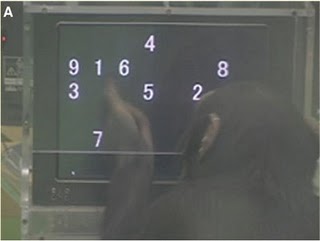
Chimpanzees, for example, beat humans at certain memory tasks (Inoue & Matsuzawa 2007) and behave more rational in reward situations (Jensen et al. 2007).
In addition, it has been shown that in tasks in the social domain, which are generally assumed to be cognitively complex, domesticated animals such as dogs and goats (Kaminski et al. 2005) fare similarly well or even outperform chimpanzees.
Social Cognition and Self-Domestication
It is entirely possible that the first signs of human uniqueness where at first simply side-effects our self-domesticating lifestyle – the same way the evolution of social intelligence in dogs and goats is hypothesised to have come about –, acting on a complex primate brain (Hare & Tomasello 2005).
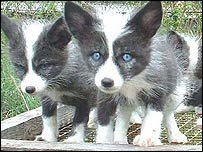 This line of reasoning is also supported by domesticated silver foxes which have been bred for tameness over a time period of 50 years but developed other interesting characteristics as a by-product: To quote from an excellent post on the topic over at a Blog Around the Clock (see also here):
This line of reasoning is also supported by domesticated silver foxes which have been bred for tameness over a time period of 50 years but developed other interesting characteristics as a by-product: To quote from an excellent post on the topic over at a Blog Around the Clock (see also here):
“They started having splotched and piebald coloration of their coats, floppy ears, white tips of their tails and paws. Their body proportions changed. They started barking. They improved on their performance in cognitive experiments. They started breeding earlier in spring, and many of them started breeding twice a year.”
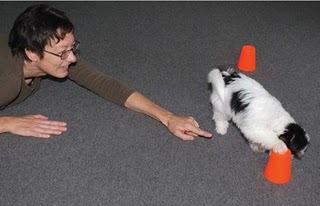
What seems most interesting to me, however, is another by-product of their experimental domestication: they also improved in the domain of social cognition. For example, like dogs, they are able to understand human communicative gestures like pointing. This is all the more striking because, as mentioned above, chimpanzees do not understand human communicative gestures like helpful pointing. Neither do wolves or non-domesticated silver foxes (Hare et al. 2005).
Physicists get linguist envy?
So I wrote a post a couple of weeks ago on my Hungarian friend’s blog in which I wrote about, amongst other things, why some linguists have physics envy, but I just read a new scientist article in which it seems physicists can have linguistics envy too!
Murray Gell-Mann, a nobel prize winning physicist (who discovered quarks), has taken it upon himself to try to work out the origins of human language:
Another pet project is an attempt to trace the majority of human languages back to a common root. Since the 19th century, linguists have been comparing languages to infer their common ancestry, but in most cases, Gell-Mann says, this kind of analysis loses the trail 6000 or 7000 years back. He says most linguists insist it is impossible to follow the trail any further into the past and – this is what truly rankles with him – “absurdly, they don’t even want to try”.
Gell-Mann heads SFI’s Evolution of Human Languages (EHL) programme. The EHL linguists say they can go even further back by classifying language families into superfamilies and even into a super-superfamily. “What we’ve found,” Gell-Mann explains, “is tentative evidence for a situation in which a huge fraction of all human languages are descended from one spoken 20,000 years ago, towards the end of the last ice age.” The team does not claim to account for all languages, though, and remains agnostic about whether they can eventually do so. “All of this just comes from following the data,” he says.
I love that attempting to trace the majority of human languages back to a common root can be described as a ‘pet project’.
If anyone’s interested here’s a paper he wrote on the subject:
Culture-driven population dynamics: sustainable or unsustainable?
![]()
![]() When looking at culture-driven population dynamics, a common assumption is that there’s a positive feedback between cultural evolution and demographic growth. The general prediction, then, is for unlimited growth in population and culture. Yet models based on these assumptions tend to ignore important aspects of cultural evolution, namely: (1) cultural transmission is not perfect; (2) culture does not always promote population growth. Ghirlanda et al (2010) incorporate these two features into a model, and arrive at some interesting conclusions. In particular, they argue those populations maintaining large amounts of culture may run the risk of extinction rather than stability or growth.
When looking at culture-driven population dynamics, a common assumption is that there’s a positive feedback between cultural evolution and demographic growth. The general prediction, then, is for unlimited growth in population and culture. Yet models based on these assumptions tend to ignore important aspects of cultural evolution, namely: (1) cultural transmission is not perfect; (2) culture does not always promote population growth. Ghirlanda et al (2010) incorporate these two features into a model, and arrive at some interesting conclusions. In particular, they argue those populations maintaining large amounts of culture may run the risk of extinction rather than stability or growth.
Continue reading “Culture-driven population dynamics: sustainable or unsustainable?”
What Makes Humans Unique? (II): Six Candidates for What Makes Human Cognition Uniquely Human
![]() What makes humans unique? This never-ending debate has sparked a long list of proposals and counter-arguments and, to quote from a recent article on this topic,
What makes humans unique? This never-ending debate has sparked a long list of proposals and counter-arguments and, to quote from a recent article on this topic,
“a similar fate most likely awaits some of the claims presented here. However such demarcations simply have to be drawn once and again. They focus our attention, make us wonder, and direct and stimulate research, exactly because they provoke and challenge other researchers to take up the glove and prove us wrong.” (Høgh-Olesen 2010: 60)
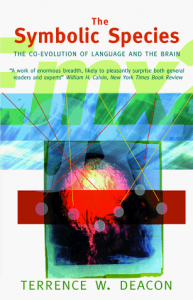
In this post, I’ll focus on six candidates that might play a part in constituting what makes human cognition unique, though there are countless others (see, for example, here).
One of the key candidates for what makes human cognition unique is of course language and symbolic thought. We are “the articulate mammal” (Aitchison 1998) and an “animal symbolicum” (Cassirer 2006: 31). And if one defining feature truly fits our nature, it is that we are the “symbolic species” (Deacon 1998). But as evolutionary anthropologists Michael Tomasello and his colleagues argue,
“saying that only humans have language is like saying that only humans build skyscrapers, when the fact is that only humans (among primates) build freestanding shelters at all” (Tomasello et al. 2005: 690).
Language and Social Cognition
According to Tomasello and many other researchers, language and symbolic behaviour, although they certainly are crucial features of human cognition, are derived from human beings’ unique capacities in the social domain. As Willard van Orman Quine pointed out, language is essential a “social art” (Quine 1960: ix). Specifically, it builds on the foundations of infants’ capacities for joint attention, intention-reading, and cultural learning (Tomasello 2003: 58). Linguistic communication, on this view, is essentially a form of joint action rooted in common ground between speaker and hearer (Clark 1996: 3 & 12), in which they make “mutually manifest” relevant changes in their cognitive environment (Sperber & Wilson 1995). This is the precondition for the establishment and (co-)construction of symbolic spaces of meaning and shared perspectives (Graumann 2002, Verhagen 2007: 53f.). These abilities, then, had to evolve prior to language, however great language’s effect on cognition may be in general (Carruthers 2002), and if we look for the origins and defining features of human uniqueness we should probably look in the social domain first.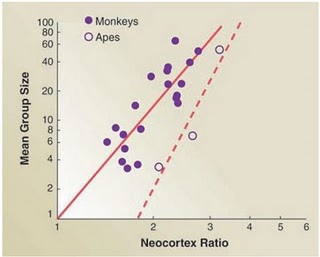
Corroborating evidence for this view comes from comparisons of brain size among primates. Firstly, there are significant positive correlations between group size and primate neocortex size (Dunbar & Shultz 2007). Secondly, there is also a positive correlation between technological innovation and tool use – which are both facilitated by social learning – on the one hand and brain size on the other (Reader and Laland 2002). Our brain, it seems, is essential a “social brain” that evolved to cope with the affordances of a primate social world that frequently got more complex (Dunbar & Shultz 2007, Lewin 2005: 220f.).
Thus, “although innovation, tool use, and technological invention may have played a crucial role in the evolution of ape and human brains, these skills were probably built upon mental computations that had their origins and foundations in social interactions” (Cheney & Seyfarth 2007: 283).
Cultural Diversity, Economic Development and Societal Instability
![]() Most of you in the science blogosphere have probably come across Razib’s recent post on linguistic diversity and poverty. The basic argument being that linguistic homogeneity is good for economic development and general prosperity. I was quite happy to let the debate unfold and limit my stance on the subject to the following few sentences I posted previously:
Most of you in the science blogosphere have probably come across Razib’s recent post on linguistic diversity and poverty. The basic argument being that linguistic homogeneity is good for economic development and general prosperity. I was quite happy to let the debate unfold and limit my stance on the subject to the following few sentences I posted previously:
From the perspective of a linguist, however, I do like the idea of really obscure linguistic communities, ready and waiting to be discovered and documented. On the flip side, it is selfish of me to want these small communities to remain in a bubble, free from the very same benefits I enjoy in belonging to a modern, post-industrialised society. Our goal, then, should probably be more focused on documenting, as opposed to saving, these languages.
Since then, the debate has become a lot more heated, with Neuroanthropology wading in against Razib, which, in the second-half of the post at least, is worth reading just to get the general flavour of the other side in this debate. Having said that, I wasn’t convinced by the evidence Greg Downey used to dismiss Razib’s hypothesis, so I decided to actually look at the literature on the subject. The first paper I found upon searching was one by Nettle et al, in which they examine the relationship between cultural diversity and societal instability using a large cross-national data set of 212 nations. Importantly, they look at cultural diversity in the context of three areas: linguistically, ethnically and religious affiliation. Also, they draw a distinction between within-nation (alpha) diversity and between-nation (beta) diversity. Lastly, unlike other studies on the subject, where simple regression or correlation methods are used, the current study employs structural equation modelling (SEM):
Continue reading “Cultural Diversity, Economic Development and Societal Instability”
What Makes Humans Unique? (I): The Evolution of the Human Brain
Hello! This is my first post here at Replicated Typo and I thought I’d start with reposting a slightly modified version of a three-part series on the evolution of the human mind that I did last year over at my blog Shared Symbolic Storage.
So in this and my next posts I will have a look at how human cognition evolved from the perspective of cognitive science, especially ‘evolutionary linguistics,’ comparative psychology and developmental psychology.
In this post I’ll focus on the evolution of the human brain.
Human Evolution
We are evolved primates. (As are all other primates of course. So maybe it is better to say that we, like all other primates, are evolved beings with a unique set of specializations, adaptations and features. )
In our lineage, we share a common ancestor with orangutans (about 15 million years ago (mya)), gorillas (about 10mya), and most recently, chimpanzees and bonobos (5 to 7 mya). We not only share a significant amount of DNA with our primate cousins, but also major anatomical features (Gazzaniga 2008: 51f., Lewin 2005: 61) These include, for example, our basic skeletal anatomy, our facial muscles, or our fingernails (Lewin 2005: 218ff.).
What most distinguishes us as humans on an anatomical level are our bizarre hair distribution, our upright posture and the skeletal modifications necessary for it, including a propensity for endurance running, our opposable thumbs, fat deposits that are unusually extensive (Preuss 2004: 5), and an intestinal tract only 60% the size expected of primates our size (Gibbons 2007: 1558).
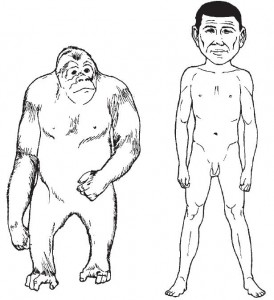 Finally, there is also a distinguishing feature that is a much more remarkable violation of expectations – a brain three times the size expected of a primate our size. This is all the more interesting as primates are already twice as encephalized as other mammals (Lewin 2005: 217). A direct comparison shows this difference in numbers: Whereas human brains have an average volume of 1251.8 cubic centimetres and weigh about 1300 gram, the brains of the other great apes only have an average volume of 316.7 cubic centimetres and weigh between 350-500 gram (Rilling 2006: 66, Preuss 2004: 8). In a human brain, there are approximately a hundred billion neurons, each of which is connected to about one thousand other neurons, comprising about one hundred trillion synaptic connections (Gazzaniga 2008: 291). If you would count all the connections in the napkin-sized cortex alone, you’d only be finished after 32 million years (Edelman 1992: 17).
Finally, there is also a distinguishing feature that is a much more remarkable violation of expectations – a brain three times the size expected of a primate our size. This is all the more interesting as primates are already twice as encephalized as other mammals (Lewin 2005: 217). A direct comparison shows this difference in numbers: Whereas human brains have an average volume of 1251.8 cubic centimetres and weigh about 1300 gram, the brains of the other great apes only have an average volume of 316.7 cubic centimetres and weigh between 350-500 gram (Rilling 2006: 66, Preuss 2004: 8). In a human brain, there are approximately a hundred billion neurons, each of which is connected to about one thousand other neurons, comprising about one hundred trillion synaptic connections (Gazzaniga 2008: 291). If you would count all the connections in the napkin-sized cortex alone, you’d only be finished after 32 million years (Edelman 1992: 17).
Expensive Tissue
The human brain is also extremely “expensive tissue” (Aiello & Wheeler 1995): Although it only accounts for 2% of an adult’s body weight, it accounts for 20-25% of an adult’s resting oxygen and energy intake (Attwell & Laughlin 2001: 1143). In early life, the brain even makes up for up 60-70% of the body’s total energy requirements. A chimpanzee’s brain, in comparison, only consumes about 8-9% of its resting metabolism (Aiello & Wells 2002: 330). The human brain’s energy demands are about 8 to 10 times higher than those of skeletal muscles (Dunbar & Shultz 2007: 1344), and, in terms of energy consumption, it is equal to the rate of energy consumed by leg muscles of a marathon runner when running (Attwell & Laughlin 2001: 1143). All in all, its consumption rate is only topped by the energy intake of the heart (Dunbar & Shultz 2007: 1344).
Consequently, if we want to understand the evolutionary trajectory that led to human cognition there is the problem that
“because the cost of maintaining a large brain is so great, it is intrinsically unlikely that large brains will evolve merely because they can. Large brains will evolve only when the selection factor in their favour is sufficient to overcome the steep cost gradient“ (Dunbar 1998: 179).
This is especially important for people who want to come up with an “adaptive story” of how our brain got so big: they have to come up with a strong enough selection pressure operative in the Pleistocene “environment of evolutionary adaptedness” that would have allowed such “expensive tissue” to evolve in the first place (Bickerton 2009: 165f.).
What About the Brain is Uniquely Human?
If we look to the brain for possible hints, we first find that presently, there is “no good evidence that humans do, in fact, possess uniquely human cortical areas” (although the jury is still out) (Preuss 2004: 9). In addition, we find that there are functions specific to humans which are represented in areas homologous to areas of other primates. Instead, it seems that in the course of human evolution some of the areas of the brain expanded disproportionally, “especially higher-order cortical areas, including the prefrontal cortex” (Preuss 2004: 9, Deacon 1998: 435-438). This means that humans are not simply ‘better’ at thinking than other animals, but that they think differently (Preuss 2004: 7). The expansion and apparent specializations of only certain kinds of neuronal areas could indicate a qualitative shift in neuronal activity brought about by re-organization of existing features, leading to a wholly different style of cognition (Deacon 1998: 435-438 Rilling 2006: 75).
This scenario squares well with what we know about the way evolution works, namely that it always has to work with the raw materials that are available, and constantly co-opts and tinkers with existing structures, at times producing haphazard, cobbled-together, but functional results (Gould & Lewontin 1979, Gould & Vrba 1982). Given the relatively short time span for the evolution of the “most complex structure in the know universe”, as it is sometimes referred to, we have to acknowledge how preciously little time the evolutionary process had for ‘debugging.’ It could well be that make the human mind is so unique because it is an imperfect ‘Kluge:’ “a clumsy or inelegant – yet surprisingly effective – solution to a problem,” like the Apollo 13 CO2 filter or an on-the-spot invention by MacGyver (Marcus 2008: 3f.). It may thus well turn out that what we think makes us so special is a mental “oddity of our species’ way of understanding” the world around us (Povinelli & Vonk 2003: 160). It is reasonable then to assume that human cognition did not just simply get better across the board, but that instead we owe our unique style of thinking to quite specific specializations of the human mind.
With this in mind, we can now ask the question how these neurological differences must translate into psychological differences. But this is where the problem starts: Which features really distinguish us as humans and which are more derivative than others? A true candidate for what got uniquely human cognition off the ground has to pass this test and solve the problem how such “expensive tissue” could evolve in the first place.
In my next post I will have a look at six candidates for what makes human cognition unique.
References:
Aiello, L., & Wheeler, P. (1995). The Expensive-Tissue Hypothesis: The Brain and the Digestive System in Human and Primate Evolution Current Anthropology, 36 (2) DOI: 10.1086/204350
Aiello, L., & Wells, J. (2002). ENERGETICS AND THE EVOLUTION OF THE GENUS HOMO Annual Review of Anthropology, 31 (1), 323-338 DOI: 10.1146/annurev.anthro.31.040402.085403
Attwell, David and Simon B. Laughlin. (2001.) “An Energy Budget for Signaling in the Grey Matter of the Brain.” Journal of Cerebral Blood Flow and Metabolism 21:1133–1145.
Bickerton, Derek (2009): Adams Tongue: How Humans Made Language. How Language Made Humans. New York: Hill and Wang.
Deacon, Terrence William (1997). The Symbolic Species. The Co-evolution of Language and the Brain. New York / London: W.W. Norton.
Dunbar, Robin I.M. (1998): “The Social Brain Hypothesis Evolutionary Anthropology 6: 178-190.
Dunbar, R., & Shultz, S. (2007). Evolution in the Social Brain Science, 317 (5843), 1344-1347 DOI: 10.1126/science.1145463
Edelman, Gerald Maurice (1992) Bright and Brilliant Fire: On the Matters of the Mind. New York: Basic Books
Gazzaniga, Michael S. (2008): Human: The Science of What Makes us Unique. New York: Harper-Collins.
Gibbons, Ann. (2007) “Food for Thought.” Science 316: 1558-1560.
Gould, Stephen Jay and Richard Lewontin (1979): “The spandrels of San Marco and the Panglossian paradigm: a critique of the adaptationist programme.” Proclamations of the Royal. Society of London B: Biological Sciences 205 (1161): 581–98.
Gould, Stephen Jay, and Elizabeth S. Vrba (1982), “Exaptation — a missing term in the science of form.” Paleobiology 8 (1): 4–15.
Lewin, Roger (2005): Human Evolution: An Illustrated Introduction. Oxford: Blackwell.
Marcus, Gary (2008): Kluge: The Haphazard Evolution of the Human Mind. London: Faber and Faber.
Povinelli, Daniel J. and Jennifer Vonk (2003): “Chimpanzee minds: Suspiciously human?” Trends in Cognitive Sciences, 7.4, 157–160.
Preuss Todd M. (2004): What is it like to be a human? In: Gazzaniga MS, editor. The Cognitive Neurosciences III, Third Edition. Cambridge, MA: MIT Press: 5-22.
Rilling, J. (2006). Human and nonhuman primate brains: Are they allometrically scaled versions of the same design? Evolutionary Anthropology: Issues, News, and Reviews, 15 (2), 65-77 DOI: 10.1002/evan.20095
The Media Noose: Copycat Suicides and Social Learning
![]()
![]() I always remember 2008 as the year when the entire UK media descended upon the former mining town of Bridgend. The reason: over the course of two years, 24 young people, most of whom were between the ages of 13 and 17, decided to commit suicide. At the time I was working in Bridgend, so I’m able to appreciate the claims of local MP, Madeleine Moon, that media influence had become part of problem. After all, most editors will tell you: the aim is to sell newspapers. And when this rule is rigorously applied, it should not come as a surprise at the depths some journalists will sink to recycle a news story. Even at a local-level, where you’d think some civic responsibility might exist, journalists clambered over themselves to find a new angle, generating ridiculous claims such as: electromagnetic waves from mobile phones caused the suicides.
I always remember 2008 as the year when the entire UK media descended upon the former mining town of Bridgend. The reason: over the course of two years, 24 young people, most of whom were between the ages of 13 and 17, decided to commit suicide. At the time I was working in Bridgend, so I’m able to appreciate the claims of local MP, Madeleine Moon, that media influence had become part of problem. After all, most editors will tell you: the aim is to sell newspapers. And when this rule is rigorously applied, it should not come as a surprise at the depths some journalists will sink to recycle a news story. Even at a local-level, where you’d think some civic responsibility might exist, journalists clambered over themselves to find a new angle, generating ridiculous claims such as: electromagnetic waves from mobile phones caused the suicides.
Continue reading “The Media Noose: Copycat Suicides and Social Learning”
Some Links #11: Linguistic Diversity or Homogeneity?
Linguistic Diversity = Poverty. Razib Khan basically argues, correctly in my opinion, that linguistic homogeneity is good for economic development and general prosperity. From the perspective of a linguist, however, I do like the idea of really obscure linguistic communities, ready and waiting to be discovered and documented. On the flip side, it is selfish of me to want these small communities to remain in a bubble, free from the very same benefits I enjoy in belonging to a modern, post-industrialised society. Our goal, then, should probably be more focused on documenting, as opposed to saving, these languages. Razib has recently posted another, quite lengthy post on the topic: Knowledge is not value-free.
When did we first ‘Rock the Mic’? A meeting of my two favourite interests over at the New York Times: Linguistics and Hip Hop. Ben Zimmer writes:
In “Rapper’s Delight,” the M.C. Big Bank Hank raps, “I’m gonna rock the mic till you can’t resist,” using what was then a novel sense of rock, defined by the O.E.D. as “to handle effectively and impressively; to use or wield effectively, esp. with style or self-assurance.” To be sure, singers in the prerap era often used rock as a transitive verb, whether it was Bill Haley promising, “We’re gonna rock this joint tonight,” or the bluesman Arthur “Big Boy” Crudup more suggestively wailing, “Rock me, mama.” But the M.C.’s of early hip-hop took the verb in a new direction, transforming the microphone (abbreviated in rap circles as mic, not mike) into an emblem of stylish display. Later elaborations on the theme would allow clothes and other accessories to serve as the objects of rock, as when Kanye West boasted in a 2008 issue of Spin magazine, “I rock a bespoke suit and I go to Harold’s for fried chicken.”
It’d be nice to see more stuff on linguistics and hip hop, and, having said that, I might write a bit on the subject. In fact, I would go as far as to say that hip hop is part of reason why I fell into linguistics: the eloquent word play encouraged, and perhaps moulded, my fascination with language. To demonstrate why, here’s a track by Maryland rapper, Edan, who certainly knows how to rock the mic:
Life without language. Neuroanthropology provides yet another great read. This time it’s on the topic of life without language — something that’s always crept into my thoughts, yet seems impossible to imagine (as I’m already so embedded within a language-using society). The post goes on to discuss Susan Schaller and the case of a profoundly deaf Mexican immigrant who did not learn sign language:
The man she would call, ‘Ildefonso,’ had figured out how to survive, in part by simply copying those around him, but he had no idea what language was. Schaller found that he observed people’s lips and mouth moving, unaware that they were making sound, unaware that there was sound, trying to figure out what was happening from the movements of the mouths. She felt that he was frustrated because he thought everyone else could figure things out from looking at each others’ moving mouths.
One problem for Schaller’s efforts was that Ildefonso’s survival strategy, imitation, actually got in the way of him learning how to sign because it short-circuited the possibility of conversation. As she puts, Ildefonso acted as if he had a kind of visual echolalia (we sometimes call it ‘echopraxia’), simply copying the actions he saw
One Man’s Take on the Facts of the Matter. Babel’s Dawn takes a look at Tecumseh Fitch’s book, The Evolution of Language, and concisely explains a clear departure between two camps in evolutionary linguistics:
One clear difference between the scenarios is in the role of the individual in relation to language. Language is somehow built into the brain in Chomsky’s thought-first scenario, while it is learned from others in the topics-first approach. Empiricists, like Morten Christiansen and Nicholas Chater, see language as ‘out there’ to be learned while nativists, like Fitch and Chomsky, say there is an internal, I-language, and the language out there is merely the sum of all those little I-languages. How to settle the dispute? Look for factual evidence.

